Читать книгу The Place of Dance - Andrea Olsen - Страница 8
На сайте Литреса книга снята с продажи.
ОглавлениеPreface
Caryn McHose and Andrea Olsen Amphitheater at Epidaurus, Greece
Photograph © Sophia Diamantopoulou
Speak the truth as you experience it; someone else can speak his or her truth.
—Bonnie Bainbridge Cohen
Dance is a place I go to know myself and the world experientially and intellectually. The creative process offers a forum in which to pose questions and investigate possibilities. I chose dance for graduate school, over my two other loves, history and biology, because dance encompasses this broad terrain. The creative process was the link.
In my writing and choreography, I often jump, assuming connections between things that might not be apparent. Edge zones bump up against each other, creating areas of heightened possibility, like the terrain between forest and field. The bane of some readers looking for continuity, these sometimes surprising juxtapositions encourage nonlinear and recursive thinking. Distinct disciplines and art forms overlap, and material cycles back on itself, offering both vitality and unity.
Modern dance making, at least since Martha Graham, has been a serious endeavor. The inner and outer lives of the dancer are under investigation. This is my lineage, seeking movement experiences where personal inquiry and ecstasy meet. Somatic practice (trusting the intrinsic intelligence of the body) and the desire for art making (the impulse to shake up habits while giving form to emerging impulses) are in conversation. Responsibility and resilience are inherent. We are embedded in larger systems, remembering our place in the larger order of things.
Writing is consistently present in my life. I remember, at age six, standing by my childhood desk and promising myself I would write—and not let schooling confuse me. I was a “good student” but not bookish. Often the title rather than the content was my jumping-off point for making dances, paintings, or stories. On the other hand, I’m reminded daily as I write that a trail of books has shaped my life: Homer’s The Odyssey, Wassily Kandinsky’s Concerning the Spiritual in Art, and Mabel Todd’s The Thinking Body at critical moments have shifted how I perceive the process of art making. With the embodied memory of those changes, this book offers a collection of possibilities for creative connections.
The author’s voice in this text is mine, a view of contemporary dance through the lens of one life. As indicated by her byline on the cover and title page, colleague Caryn McHose offered much vision and time to this book. Indeed, many parts would simply not have existed without our three decades of intense collaboration. Ideas from co-teaching and shared explorations suffuse the work. My desire is thus to claim Caryn as an essential colleague and to acknowledge her work, even though I must take responsibility for the words themselves. Beyond the two of us, the book also enters into dialogue with the ideas of many other people who make dances, engage the body, and consider the values of art making.
In our collaborative process, I’m a notetaker and proliferator of ideas. Caryn is intuitive and distills. We both are rooted in the art of dance, the Midwest landscape, and a heritage of seeing with undergraduate degrees in visual arts. Caryn brings diverse influences to her teaching: her heritage of outdoor improvisation with Betty Jane Ditmar, Continuum with Emilie Conrad and Susan Harper, tonic function with Hubert Godard, Somatic Experiencing with Peter Levine’s training program, years of private practice in embodied movement, and her shared writing and research investigations with Rolfer/husband Kevin Frank. I bring my training in ballet and with modern dancers (Martha Graham, José Limón, Merce Cunningham), along with depth of study in anatomy and philosophy with Dr. John M. Wilson, experiential anatomy with Bonnie Bainbridge Cohen, the discipline of Authentic Movement with Janet Adler, and environmental education and writing with John Elder, plus years of performing. Caryn and I share influences and value various modes of articulation: touch, word, and performance.
At some point, we both picked up The Thinking Body and felt a shift in our dancing toward somatic practices. Together, we created our own weave of explorations and synthesis of information. Our prior collaborations are embedded in three books: BodyStories, Body and Earth, and How Life Moves. Our current collaboration is rooted in a seven-year Body and Earth Training program taught in Wales and other sites in England and Italy with a dedicated group of students. In this period, we developed the practices and philosophy that underlie this book, culminating in a BE-ING (Body and Earth-ing) score for outdoor dancing. In this book, ten specific exercises are shared and sequenced in what Caryn calls a “body of inquiry,” included through the “To Do” section of each chapter. Our intention is that skills for embodied awareness are applicable in life as well as on stage.
We’re not going to tell you everything. This is not a recipe book or traditional how-to. It’s soil and seeds; you nourish what you like, what catches your attention and is useful. We offer a sequence, but you can be independent and enter anywhere in the progression. Backtrack, hop forward, turn around, and stretch into your imagination. Follow your curiosity.
Andrea Olsen, 2013
